Supermicro A2SDi-8C+-HLN4 Intel Atom C3758 Benchmarks
For this exercise, we are using our legacy Linux-Bench scripts which help us see cross-platform “least common denominator” results we have been using for years as well as several results from our updated Linux-Bench2 scripts. At this point, our benchmarking sessions take days to run and we are generating well over a thousand data points. We are also running workloads for software companies that want to see how their software works on the latest hardware. As a result, this is a small sample of the data we are collecting and can share publicly. Our position is always that we are happy to provide some free data but we also have services to let companies run their own workloads in our lab, such as with our DemoEval service. What we do provide is an extremely controlled environment where we know every step is exactly the same and each run is done in a real-world data center, not a test bench.
We are going to show off a few results, and highlight a number of interesting data points in this article.
Python Linux 4.4.2 Kernel Compile Benchmark
This is one of the most requested benchmarks for STH over the past few years. The task was simple, we have a standard configuration file, the Linux 4.4.2 kernel from kernel.org, and make the standard auto-generated configuration utilizing every thread in the system. We are expressing results in terms of compiles per hour to make the results easier to read:
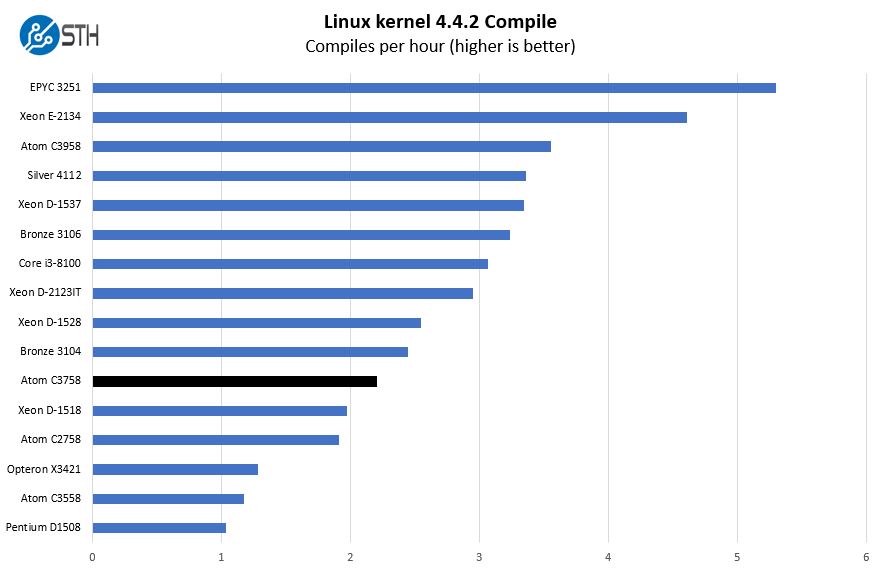
Here we wanted to draw a comparison between the Supermicro A2SDi-8C+-HLN4F and its 8-core Intel Atom C3758 SoC and the previous-generation 8-core Intel Atom C2758 processor. One can see a large performance boost even at the same core count, and that will increase in many of the other benchmarks we have.
c-ray 1.1 Performance
We have been using c-ray for our performance testing for years now. It is a ray tracing benchmark that is extremely popular to show differences in processors under multi-threaded workloads. We are going to use our 4K results which work well at this end of the performance spectrum.
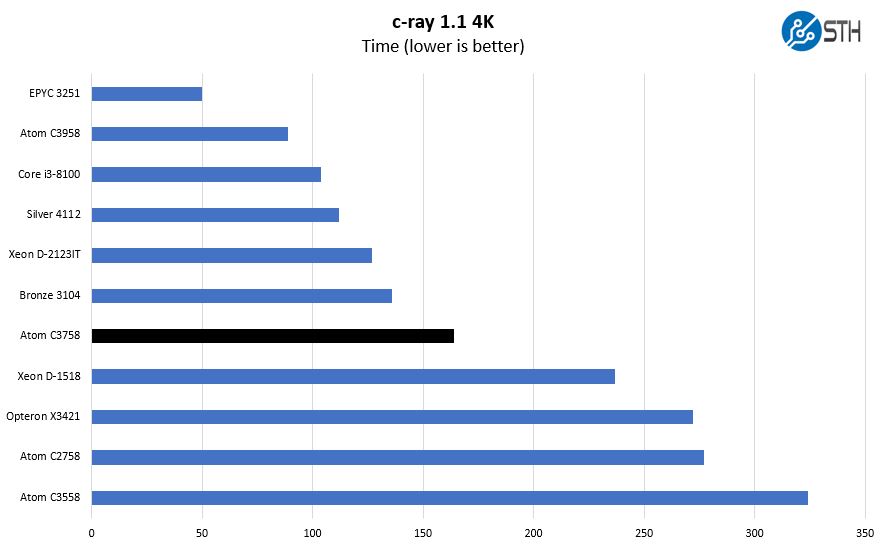
Here we see the Supermicro A2SDi-8C+-HLN4F and its Intel Atom C3758 significantly outpace the Intel Xeon D-1518 4C/8T CPU. That is intriguing as the Intel Xeon D-1518 is a 35W TDP part compared to 25W for the Atom C3758.
7-zip Compression Performance
7-zip is a widely used compression/ decompression program that works cross-platform. We started using the program during our early days with Windows testing. It is now part of Linux-Bench.
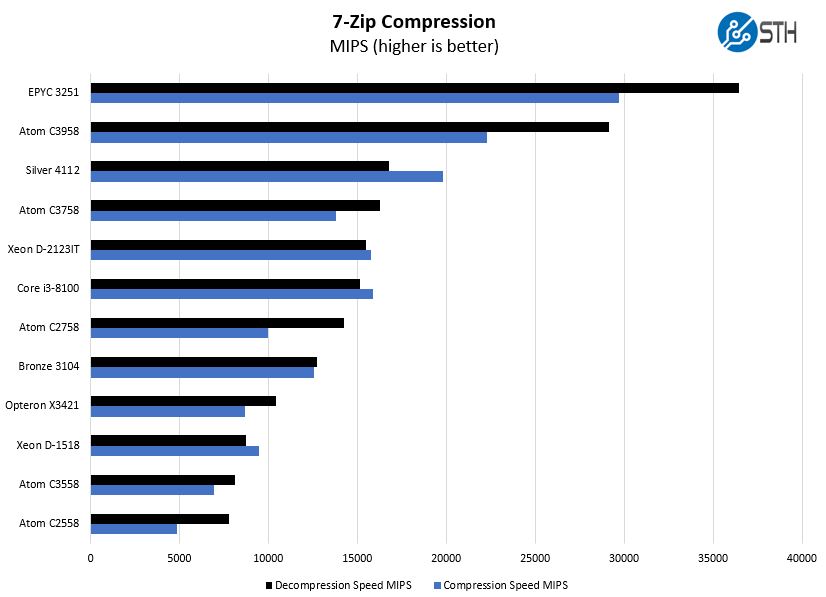
On the compression side, we again see some significant gains. We expect that the Supermicro A2SDi-8C+-HLN4F acting in network or storage modes may have to perform compression/ decompression tasks making this highly relevant.
Sysbench CPU test
Sysbench is another one of those widely used Linux benchmarks. We specifically are using the CPU test, not the OLTP test that we use for some storage testing.
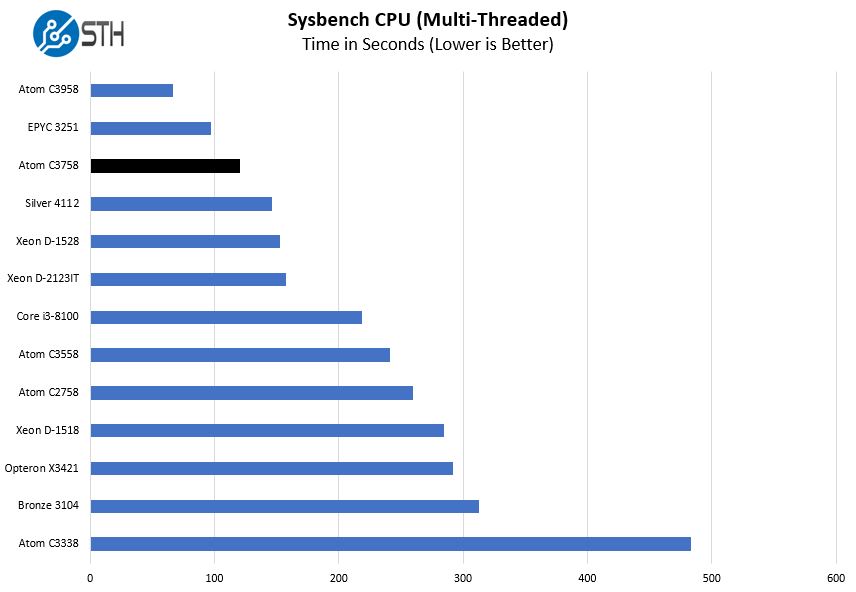
Here we see a simple expression of having 8 cores helping in this test. The more cores here, generally the better CPUs do which benefits the Supermicro A2SDi-8C+-HLN4F. There are tasks where simply being able to run more in parallel is beneficial.
OpenSSL Performance
OpenSSL is widely used to secure communications between servers. This is an important protocol in many server stacks. We first look at our sign tests:
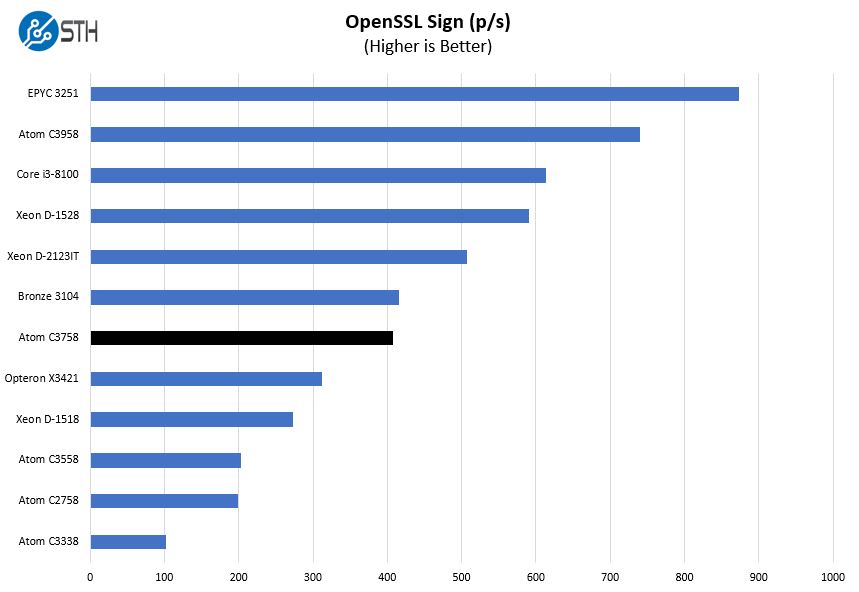
Here are the verify results:
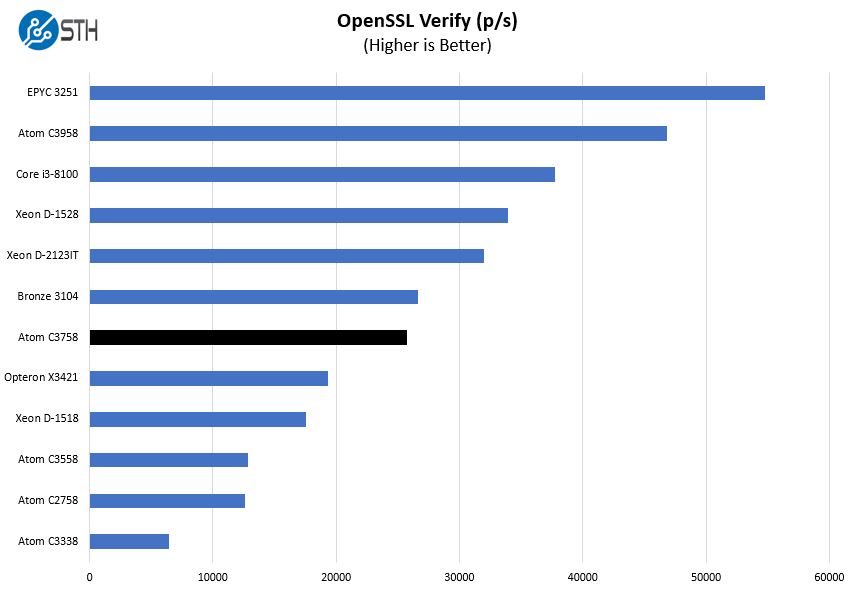
A note here, these are using the standard CPU features, not Intel QuickAssist technology onboard the Supermicro A2SDi-8C+-HLN4F. Intel QAT is an accelerator for compression and encryption that is now several generations old. More programs are now supporting QAT but it still requires explicitly declaring support rather than being a built-in feature.
Intel needs to do a better job expanding the QAT reach to more of its SKUs so we can finally get encryption for “free” on its CPUs.
If you are an ISV looking to take advantage of QAT in a solution based on the Supermicro A2SDi-8C+-HLN4F we showed its potential in our Intel QuickAssist at 40GbE Speeds: IPsec VPN Testing and Intel QuickAssist Technology and OpenSSL Benchmarks and Setup Tips pieces. There are clear benefits if you can use QAT in your solution.
UnixBench Dhrystone 2 and Whetstone Benchmarks
Some of the longest-running tests at STH are the venerable UnixBench 5.1.3 Dhrystone 2 and Whetstone results. They are certainly aging, however, we constantly get requests for them, and many angry notes when we leave them out. UnixBench is widely used so we are including it in this data set. Here are the Dhrystone 2 results:
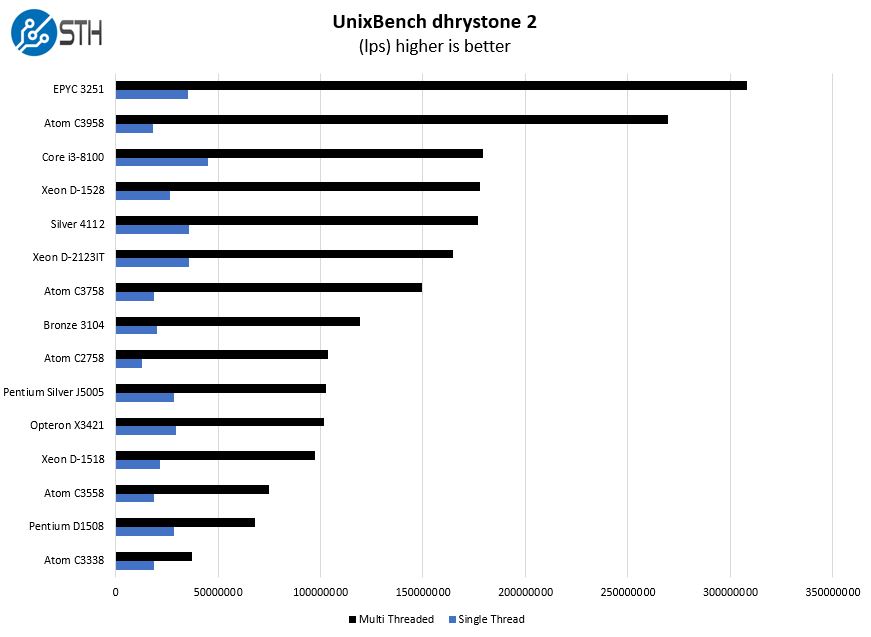
Here are the whetstone results:
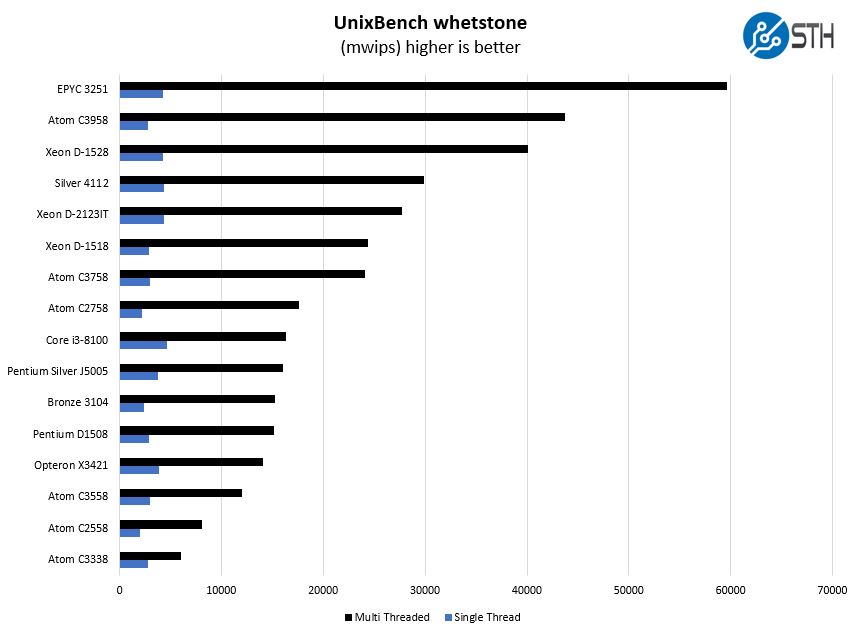
Here the Supermicro A2SDi-8C+-HLN4F Intel Atom C3758 per-thread performance is not necessarily the best, however, one can clearly see that having many cores helps. Also, there is a large single thread performance boost over the Intel Atom C2758 which is how the Denverton series Intel Atom C3758 is seeing such large performance gains over its predecessor.
Chess Benchmarking
Chess is an interesting use case since it has almost unlimited complexity. Over the years, we have received a number of requests to bring back chess benchmarking. We have been profiling systems and are ready to start sharing results:
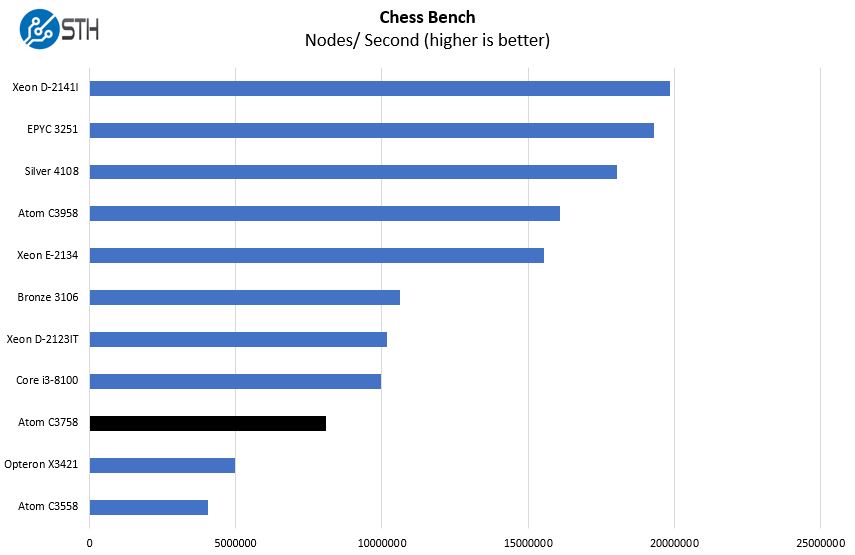
On the chess benchmarking side, one can again see the higher clock speed parts take over. We think that one needs to gauge how well their workload matches the new Atom C3000 cores. With this generation, there have been massive performance improvements so more workloads are going to align with the Supermicro A2SDi-8C+-HLN4F’s Intel Atom C3758 than the previous generation Atom C2758.
Next, we are going to look at the Supermicro A2SDi-8C+-HLN4F power consumption followed by our final words.




How does this compare to the Epyc 3000 series on a performance/$ aspect?
Thanks for mentioning the H-TF (10GbE) version. I guess there wasn’t room for a couple 1GbE too. But only ~$100 more for 10GbE doesn’t seem so bad (per Amazon).
This one is nice, since it has the 2x 8643 headers. One PciE slot… I’d have to decide between a M.2 sled or 10GbE… though I wouldn’t get many M.2 drives, most likely just one extra :(
Interesting little product. I like the twin SFF 8643 ports. I would like to see them progress to PCIe 4 becuase there are time when using two RAID 10 Vols on a Areca 12G 1883ix-24 that I will saturate the 12G bandwidth.
Park they can’t just progress. It’s limited by the Intel chip. No Intel chips have PCIe4 to this day
Any idea if the C2000 bug still existing on this new platform? I am considering about this but worry about C2000 bug still “carry out” to C3000 platform.
I own this board and I’m not able to reach 14W in idle. My result is 21W with only IPMI connected, one SATA SSD and one RAM module, so I contacted Supermicro and this is their answer:
“we do not have figures for the 8C model but we do have them for 12C model which is also 25W TDP.
The idle consumption was 26.19W, your result of 21W seems normal to us.
We do not know how serverthehome got those figures.”
So how do you meassured 14W? I’m very disappointed about the idle power consumption because the predecessor had a similar low consumption and now its much more (for a Mini ITX project).
Could you provide a bit more information as to how you test power consumption? You specify the measuring device, but not the PSU used (its efficiency obviously affects the test), and any connected peripherals.
Where to buy it?